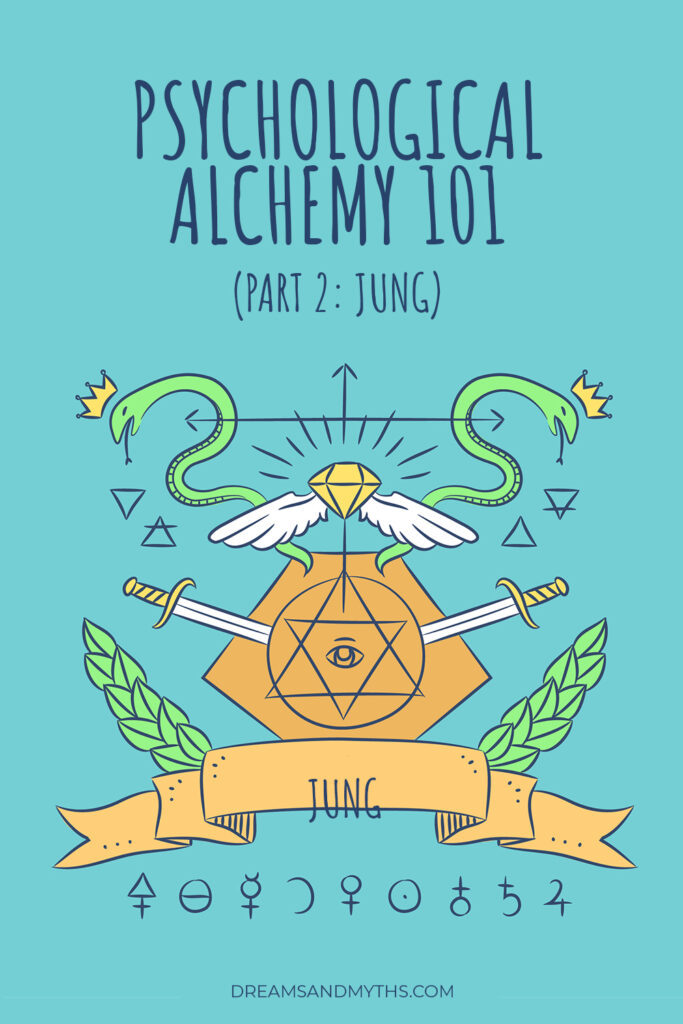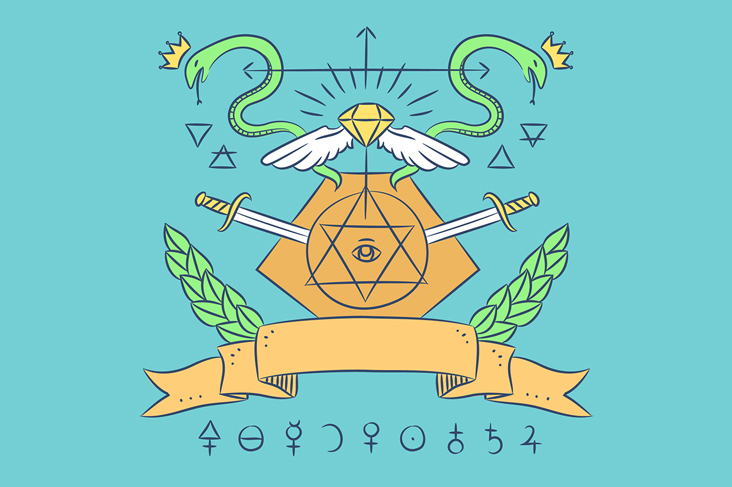In part 2 of Psychological Alchemy, we’re going to explore the connection between the mystical laboratory art and the inner workings of your psyche. Borrowing ideas and insights from Jung and the larger Hermetic stream, the Magnum Opus can provide powerful tools for transformation and individuation.
——————————————————————————————————————–
Welcome back! Please, take a seat.
If you haven’t read part 1 of Psychological Alchemy, I encourage you to go over it. I’ve outlined some important concepts that will come in handy when it comes to understanding the psychotransformative side of alchemy.

For the longest time, the Great Work was considered a primitive form of the scientific method. The adept would dress alchemical processes in mythological terms and metaphors, thus creating an impression of superstition and religious dogma.
It wasn’t until Jung popularized the concept of Inner Alchemy that we began deciphering the codes and language of alchemy.
Of course, for mystics that wasn’t anything new. Secret societies possessed this kind of knowledge for centuries, creating massive systems of complex psychoanalysis for their initiates. They called it “theurgy”, “apotheosis”, “the Operation of the Gods”.
Theurgy and Conversation with the Higher Genius
When we think of the word genius, the image of a polymath or a high IQ individual comes to mind. But its true meaning has to do with the divine nature that resides deep within every one of us.
We encounter this concept across many cultures. Whether it’s the guardian angel in Catholicism or what we call today intuition represents the idea of the peak of human consciousness.
But what does it mean to interact with this “entity”? And is it an entity?
Well, this is where things get complicated. If we take a look at the methods people have been using to access their higher genius, you might think… they’re outright crazy! Or, are they?
Many of the rituals we’ve inherited from the syncretic nature of religions aim to exalt the spirit towards a productive psychological state that encourages the embodiment of this ideal. I’m sure you’ve been in a temple, hearing the psalms, observing priests make a cross in the air, using tools to enact symbolic gestures, etc.
What we don’t know, rather, what we’ve forgotten is that from ancient Egypt and Greece to Medieval times, these rituals were a form of psychodrama; an enactment of certain myths*. This dramatization sought to cause psychological changes!
*The King’s Ritual in Egypt, the Eleusinian mysteries, the Alexandrian secret societies are testament to this.
And while Gods, Angels, and mythological creatures were evoked during them, in reality, they’re psychological archetypes we must integrate. Egregores, psychological intelligences that reside within our unconscious. We’ve shaped and organized our psyche in a way that impregnates conscious reality with symbols and myths. Depending on your culture, they might have a different appearance… but they’re the same thing!
(In part 1, I talk about the Hermetic prisca theologia)
The experience of participating in the theurgic process might convince you it’s all external. Fortunately, today we have the tools to establish a hermeneutic that strips away the religious jumble of dogma and superstition and reclaims the true essence of these practices.
Theurgy = Individuation
Projection. A concept that revolutionalized how we think of ourselves, as well as how we interact with others and the external environment.
Everything that’s happening inside of us is manifested, often unconsciously, externally.
“Until you make the unconscious conscious, it will direct your life and you will call it fate.”
In that context, the theurgic process is about retracting these projections, integrating and embodying them.
Our fragmented identity becomes whole again. In Unity, we learn ourselves.
This is Psychological Alchemy.
Spagyric Psychology

Even if you’re completely unfamiliar with alchemy or psychology, I think you can clearly see the connection, right?
We begin with separation (the subject starts splitting itself to experience consciousness) and then, after purifying and perfecting each aspect of the self, we begin to recombine the elements (our projections) to create the Philosopher’s Stone (individuation).
And old alchemists knew that.
“… [they] are not concerned with material substances but are employing the language of exoteric alchemy for the sole purpose of expressing theological, philosophical, or mystical beliefs and aspirations”.
Mercury, lead, and salt might be degraded and destroyed… but philosophical mercury is eternal. It’s the transformative agent that can alter the soul.
Jung was able to understand this distinction that alchemists made time and time again. He saw the mythology and symbolism behind esoteric knowledge, the God Mercury and the symbol of the Caduceus, Sol and Luna, the Ouroboros as the Shadow, and applied his rigorous psychoanalytic method:
“When the alchemist speaks of Mercurius, on the face of it he means quicksilver (mercury), but inwardly he means the world-creating spirit concealed or imprisoned in matter. The dragon is probably the oldest pictoral symbol in alchemy of which we have documentary evidence. It appears as the Ouroboros, the tail-eater, in the Codex Marcianus, which dates from the tenth or eleventh century, together with the legend ‘the One, the All’. Time and again the alchemists reiterate that the opus proceeds from the one and leads back to the one, that it is a sort of circle like a dragon biting its own tail. For this reason the opus was often called circulare (circular) or else rota (the wheel). Mercurius stands at the beginning and end of the work: he is the prima materia, the caput corvi, the nigredo; as dragon he devours himself and as dragon he dies, to rise again in the lapis. He is the play of colours in the cauda pavonis and the division into the four elements. He is the hermaphrodite that was in the beginning, that splits into the classical brother-sister duality and is reunited in the coniunctio, to appear once again at the end in the radiant form of the lumen novum, the stone. He is metallic yet liquid, matter yet spirit, cold yet fiery, poison and yet healing draught – a symbol uniting all the opposites.”
How to Apply Psychological Alchemy in Your Life?
There are quite a few systems (operations) in alchemy, depending on the prima materia. The original recipe to create the lapis corresponded with four colours; black, white, yellow, red. Each one is a reflection of the pyrolytic process of matter.
We’ll break each one down and the psychological correspondences, and expand them to the classical seven stages of psychological alchemy.
Nigredo
The first stage of alchemy is to “burn” all impurities from the imperfect subject. Through fire and heat, it turns black, into ashes.
There’s a saying old adepts used to say: “Our (Great) Work begins in blackness and death”. Indeed, the beginning of individuation begins with what Jung called “Shadow Work”. The dark night of the soul will come for everyone walking this path, and it’ll reveal all that is hidden.
Insecurities, guilt, shame, maliciousness. They’ll come forth and challenge your assumptions about yourself and reality. The integration will come slowly and painfully. Like the Ouroboros biting its own tail, Shadow work never ends. We keep finding new dark corners and illuminating them.
Practical tip: Journal every significant event in your life, and jot down the kinds of emotions you felt, both positive and negative.
Albedo
The intimate connection between the conscious and subconscious mind is often severed, the result of a defence mechanism protecting you from the unknown.
This stage is about re-establishing that direct communication line. An honest, ongoing conversation needs to be facilitated. The keyword here is trust. Trust your intuition, and follow your guts. You’ll be wrong in the beginning. A lot. That’s fine. It takes a blind man to see.
Practical tip: Keep a dream journal. Dreams are symbolic messages your subconscious mind is sending you. But also, follow your gut even if it means you’ll screw things up in the short term.
Citrinitas
Time to find yourself in others. Projection is a fundamental function of human psychology. It enables us to connect, experience empathy, and commit to each other regardless of our differences and shortcomings.
Yet, when the individual is struggling to balance the animus/anima axis, his projections become sacrificial. They’ll become empty of innate emotions, spent on the external world as a means of protecting their fragile ego.
In order to achieve the great alchemical marriage of the opposites, you need to take responsibility for your own emotions and motivations.
Practical tip: Don’t shy away from meaningful arguments. Express how you feel and seek connection with individuals who will challenge you.
Rubedo
“Who looks outside, dreams; who looks inside, awakes.”
Remember how I said that the theurgic process makes people feel that everything is happening on the outside?
Well, the Rubedo is about recognizing the sleeping giants inside of us. Archetypes and symbolism emerge from the depth of the collective unconscious, influencing our fate in unprecedented ways.
To give shape and order to chaos is to create your personal mythology.
Practical tip: Use myths and stories to articulate the intangible.
These four stages don’t always have a clear beginning and end. For most people, it’ll be an ongoing process, making slow progress over time.
The goal of individuation isn’t to become THE perfect human. No. The goal is to become who you truly are.
The 7 Classical Steps of Spiritual Alchemy
This isn’t a perfect 1:1 correspondence. After all, we’re dealing with archetypes that are personal, and subjective, even if they’re in some way rooted in the collective unconscious.
Calcination
Alchemy: Turning the substance into ashes. The first step of pyrolysis.
Psychology: The ego is dissolved. You begin relating yourself to the outer world as a sovereign individual.
Dissolution
Alchemy: Dissolve ashes in water.
Psychology: The conscious mind takes a backseat while the unconscious mind works its way to the limelight.
Separation
Alchemy: Split the solution into two parts.
Psychology: Start integrating part of the unconscious, from shadow to light.
Conjunction
Alchemy: A new substance is created
Psychology: The new self starts emerging.
Fermentation
Alchemy: Break down the new substance using solvents or bacteria.
Psychology: Test the strength of your character. Challenges will pop up. Use your newly found inner power to cut them down.
Distillation
Alchemy: Boil and purify the solution.
Psychology: The spirit is free of “imperfection”. Childish ego doesn’t control you anymore.
Coagulation
Alchemy: Vapor, water, and debris combine into one, solid-state.
Psychology: Unconscious and conscious become One.
This is the end of the alchemical process. At what stage are you?
The Elixir of Life
Humans are obsessed with beating death. Some argue that we’re on a long journey towards immortality. Technology certainly seems capable of extending life beyond what’s “natural”.
Yet, the Elixir of Life wasn’t about mundane life. No.
See, life is infinite. We choose to cut slithers of the whole and call it order. In reality, everything is happening right now. Not tomorrow, not yesterday. Now.
In these moments, fleeting moments escaping our grasp, we can find the whole. Unity is the experience of everything here and now. The realization that there are no boundaries to the human psyche. And as long as we turn inwards, we can expand and fill the space of existence with the neverending awareness of the One in us.
“People will do anything, no matter how absurd, to avoid facing their own souls. They will practice Indian yoga and all its exercises, observe a strict regimen or diet, learn theosophy by heart, or mechanically repeat mystic texts from the literature of the whole world – all because they cannot get on with themselves and have not the slightest faith that anything useful could ever come out of their souls. … It is rewarding to watch patiently the silent happenings in the soul, and the most and the best happens when it is not regulated from outside and from above. I readily admit that I have such a great respect for what happens in the human soul that I would be afraid of disturbing and distorting the silent operation of nature by clumsy interference”
